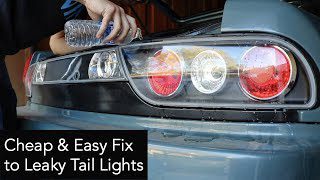To reseal tail lights, remove the housing, clean the surfaces, apply a silicone sealant, and reassemble. Ensure the sealant is evenly distributed to prevent moisture ingress.
Resealing tail lights is a crucial maintenance task that prevents water and moisture from damaging your car’s electrical components. Tail lights are consistently exposed to harsh weather conditions, necessitating periodic resealing for optimal performance and longevity. Moisture within the tail light assembly can lead to reduced visibility and safety, as well as potential electrical issues.
A clear guide on DIY resealing can save car owners the cost of professional servicing while extending the life of their tail lights. It’s important to select the right type of sealant and to apply it carefully to ensure a watertight seal. A well-sealed tail light not only functions better but also helps maintain the car’s aesthetic appeal.
Gathering Materials
Before embarking on resealing tail lights, it’s vital to have the necessary materials on hand. Ensure you have a quality silicone sealant specifically designed for automotive use. This sealant will be the key component in creating a waterproof barrier and preventing future moisture issues.
Cleanliness is crucial, so a microfiber cloth is recommended for wiping down the surfaces. This type of cloth is gentle on the tail lights and effective at removing debris without leaving residue. Lastly, a screwdriver that matches the screws of your tail light assembly is essential for disassembly and reassembly during the sealing process.
| Material | Purpose |
| Silicone Sealant | To create a waterproof barrier on the tail lights. |
| Microfiber Cloth | To clean the tail lights without scratching the surface. |
| Screwdriver | To disassemble and reassemble the tail light housing. |
Preparing The Tail Lights
Preparing your tail lights for resealing is a critical step towards preventing moisture build-up and potential damage. Clean the surface meticulously to ensure the adhesive bonds properly. Begin by removing any dust, dirt, or grime using a soft, lint-free cloth and a mild cleaner that won’t degrade the light cover. For rigorous cleaning, use isopropyl alcohol; it’s effective in removing grease and does not leave a residue. Subsequent to cleaning, the tail lights should appear spotless and free of contaminants.
Removing the tail lights requires a delicate approach to avoid damaging the housing or the vehicle. Disconnect the car’s battery first to prevent any electrical issues. Locate the screws or bolts holding the tail light assembly in place—typically found inside the trunk or along the rear compartment’s perimeter. Gently unscrew these fasteners and carefully slide out the tail light assembly. Make sure to keep all screws and components organized for a hassle-free reinstallation process after resealing.
Inspecting For Damage
Inspecting for damage on tail lights is crucial to ensure they are in proper working order. Start by checking for cracks on the surface. These can often be hard to spot, so a thorough examination in good lighting conditions is recommended. Small fissures can lead to more significant issues if left unrepaired.
Assessing water damage is also key. Trapped moisture can cause fogging and electrical problems within the lighting assembly. Look for signs of condensation or corrosion around the seal. Should you discover any water ingress, it’s imperative to address it immediately as it can compromise the functionality and longevity of your tail lights.
Applying Masking Tape
Before beginning the resealing process, ensuring the preservation of your vehicle’s paint is crucial. Use high-quality masking tape to cover the edges of the tail lights, sticking firmly to the car body. This barrier acts as a protective shield against any excess sealant or accidental scratches.
Delicately apply the tape round the perimeter of the tail lights, leaving no gaps for sealant to seep through. Taking the time to cover adjacent areas can prevent unnecessary cleanup and maintain the pristine condition of the paintwork. The fineness of the job hinges on the meticulous attention paid during this preparatory stage.
Applying The Sealant
Applying the sealant to reseal tail lights effectively requires meticulous attention to filling in cracks and gaps prior to smoothing it out. Tail lights are exposed to various environmental factors, making a watertight seal crucial to prevent moisture buildup.
Begin by cleaning the surface thoroughly to ensure the sealant adheres correctly. Use a quality adhesive sealant designed for automotive use. Apply the sealant directly into the cracks, making sure it fills all voids. For gaps, a steady hand is necessary to create an even flow of sealant, thereby preventing future water ingress.
Once all imperfections are addressed, smooth the sealant using a spatula or your finger coated with soapy water to prevent sticking. This step is important to achieve a neat finish, ensuring that the sealant spreads evenly across the surface and bonds well with the tail light housing. Lastly, allow ample drying time as recommended by the sealant manufacturer before re-installing the tail lights.
Reattaching The Tail Lights
After applying sealant to the tail light edges, it’s time to secure the lights in place. Firmly press the tail light assembly back onto the vehicle ensuring that it fits snugly without any gaps. It’s crucial to allow the sealant time to cure according to the manufacturer’s instructions; this typically takes several hours. Once cured, test the strength of the bond by gently pressing around the edges of the tail lights.
To test for leaks, wait for a dry day and gently spray water around the sealed areas. Observe closely for any moisture inside the tail lights. If you identify any leaks, additional sealant may be required to reinforce the waterproof barrier. Keep in mind that any compromise in the sealant can lead to moisture accumulation, which might damage the tail light electronics or reduce visibility.
Maintaining Resealed Tail Lights
Maintaining resealed tail lights requires regular inspections to prevent moisture buildup and ensure their longevity. It’s essential to examine the sealant’s condition frequently and look for any signs of wear and tear. You’ll want to take prompt action if you notice any cracks or gaps to prevent further damage.
As part of cleaning and maintenance advice, keeping your tail lights dirt-free is crucial. Use a soft, clean cloth along with recommended cleaning agents to wipe the exterior surface gently. This practice not only maintains clear visibility but also helps you spot any sealing issues early on. Preventative care like this helps to avoid moisture intrusion which might lead to more significant problems down the line.

Credit: www.reddit.com
Frequently Asked Questions For How To Reseal Tail Lights
What Do You Use To Seal Tail Lights?
To seal tail lights, use a silicone-based sealant or automotive butyl rubber sealant for a watertight bond. Ensure surfaces are clean before application for best results.
How Do You Fix A Leaking Tail Light?
Identify the leak source in the tail light assembly. Remove the tail light cover and clear any moisture. Reseal the edges with a high-quality silicone sealant. Allow it to dry completely before reattaching the cover. Ensure all seals are tight to prevent future leaks.
How Do I Stop Moisture In My Tail Lights?
To stop moisture in tail lights, ensure seals are intact, replace damaged gaskets, and use a silicone sealant for extra protection. Keep vent tubes clear and consider using small desiccant packs inside the housing to absorb moisture.
What Is The Best Glue For Tail Lights?
The best glue for tail lights is a strong, weatherproof automotive adhesive such as 3M Auto Advanced Plastic Emblem and Trim Adhesive. Use silicone-based adhesives for their flexibility and resilience.
Conclusion
Sealing tail lights properly is crucial for longevity and safety. With the right tools and steps, you can prevent moisture and preserve clarity. Remember, patience and accuracy are key to a successful reseal. Drive confidently, knowing your tail lights are as resilient as they are bright.
Stay safe on the roads!


